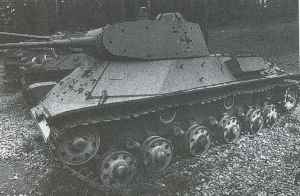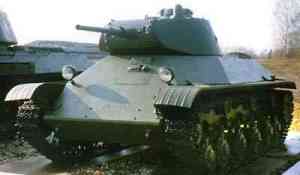Despite the development of the formidable T-34, the idea of a new mass-produced tank emerged inside the Soviet military circles. So two Soviet factories in Leningrad (Kirovsky factory and Voroshilovsky factory #174) were ordered to develop a new 14-ton tank armed with 45 mm gun and protected by medium armor, similar to T-34.
In 1939, the Kirovsky factory was ordered to develop a light CS tank (close support tank). In 1940 the first prototype, named "Object 126" or T-126SP, was developed, manufactured and tested. Its protection was equal to the T-34's: its welded hull was assembled from 37 mm homogeneous armor plates; its roof was composed of 20 mm plates. Frontal, upper side and rear armor plates were sloped 40-57 degrees.
The new tank did have the 45mm Tank Gun Model 1932/38 supplied with 150 rounds plus a coaxial 7.62 mm DT machine-gun. Additionally, it was armed with the 7.62 mm DS bow machine-gun. The tank was powered by a 250 hp V-4 diesel engine, which provided the 17-ton vehicle with a maximum speed of 35 km/h.
The tank had torsion bar suspension. Its chassis consisted of six steel road wheels (each with internal shock absorber), idler, rear driver wheel with removable cogged rim, and three support wheels. The transmission consisted of the two-disk main friction clutch, the 4-speed gearbox, multiple-disk side clutches and side gears.
Measured by aggregate armament and protection, "Object 126" was superior to most of the Soviet light and medium tanks of that time. In fact, the German Pz-III played a notable role in development of the "Object 126". Having many advantages, the Soviet tank had some disadvantages as well. First of all, it had limited range and little room for crew. On the second prototype the internal room was increased by removing the DS machine-gun.
The second prototype received new lighter road wheels with rubber tires. Simultaneously, at LKZ factory (Kirovsky factory) engineer L.S.Troyanov developed another variant, named "Object 211". Both tanks were sent to comparison trials which the first tank ("Object 126") won. On February 12, 1941,"Object 126" was accepted for servise and named T-50. T-50 was intended to be the most mass-produced Soviet tank. It was the very first Soviet tank successfully passed all steps of Govermental Trials without any fails.
In their construction the T-50 and the "Object 126" were quite similar. Like its prototype, the T-50 had well-sloped welded armor. The driver's hatch was located in the upper frontal armor plate. Bow machine-gun was absent. T-50's design was hi-tech and weighed only 13.5 tons, with 37-mm frontal armor on hull and turret. The three-man conical turret had a commander's cupola with six vision slits. The turret was welded, of conic form, with flat rear armor hatch. The T-50 was still armed with the 45-mm 20K gun model 1932/38 and one coaxial 7.62 mm DT TMG.
The T-50 had the torsion bar suspension with road wheels with internal shock absorbers. The tank was powered by 300 hp V-4 diesel engine (specific power - 21 hp/ton). Average ground pressure - 0.57 kg/cm2, top speed - 60 km/h. All tanks were equipped with radio.
On those times point of view, the T-50 was intended to be a kind of "universal" tank and should replace T-26s and BTs light tanks.
Here I would like to notice, the T-50 wasn't light tank, also it wasn't intended to be light. According to the nomenclature of that time, the T-50 was rather a support tank for motorised and mechanised troops of the Red Army.
At that time, an artillery testings congucted at NII-48 Research Lab. These tests proved the T-50 couldn't be penetrated by the Soviet 76 mm Gun Model 1939 at 400 metres at any angle. Moreover, during these tests, the T-50 wasn't penetrated by the ex-German PaK 40 antitank gun, while the T-34 was penetrated three times.
In April 1941, the T-50 was accepted for service. Until the beginning of the Great Patriotic War, factory #174 produced not a single T-50, however. The most serious problem was with V-4 engine that was in fact very unreliable and expensive. Till the end of war, Soviet industry was unable to build an efficient and reliable V-4. Through extreme efforts Soviet industry was able to produce 50 tanks during the second half of 1941. An attempt to set up mass production of T-50 at Factory #37 in Moscow failed.
In August 1941, the Factory #174 was evacuated: mostly in Omsk, but several parts in Nizhnij Tagil and Barnaul. On October 13, 1941, the GOKO issued an order to build two new factories in Barnaul: the first to manufacture T-50s and the second to manufacture diesel engines for the T-50. However, in January 1942, the manufacture of the T-50 and its engines was cancelled and never resumed. Factory #174 in Omsk manufactured 15 T-50s, but then was switched to building T-34s.
History has left few combat records of this very interesting tank. I know only that T-50 tanks manufactured in Leningrad served in one of the Soviet tank brigades on the Karelian Isthmus. Some were captured by Finns and used till the end of war (1944).
The T-50 was adequately protected, its armor protection was almost equal to T-34. Tank was intended to rearm with 57mm ZIS-4 Tank Gun. Its speed and maneuverability was much better then T-34. Also, the commander's cupola and restricted duties of the tank commander were also important improvement (comparing to the T-34). The steel intensity of the T-34 was twice as much then T-50. So why the production of such advanced tank was ceased? In fact, there were three reasons. At first, the mass production was tried to set up after the beginning of the Great Patriotic War. At second, from autumn 1941, the Red Army began to receive British and Canadian "Valentine" tanks, which were quite close to the T-50 (with exception to maneuverability). At third, there were no available factory ready to produce V-4 engines.
That's why the fate of the T-50 was so short. Only 69 T-50 tanks were manufactured; after that it was finally removed from production.
Important to mention there were two types of T-50 distinguished by different armor thickness: the first one was 37-41 mm, the second one was 55-57 mm.
It's important to mention another variant of T-50: the "Object 211", which was developed by LKZ's Design Bureau headed by A. S. Ermolaev. It had a welded hull and conical turret. The armament and engine were the same as the production T-50, though "Object 211" was lighter. Anyway, it didn't have any superiority over production T-50. Only one vehicle was manufactured and that was before the war.
After the beginning of the Great Patriotic War, all further works on this project were cancelled. The single "Object 211" was used in defense of Leningrad and its further fate is unknown - list it as "missing in action".
|










